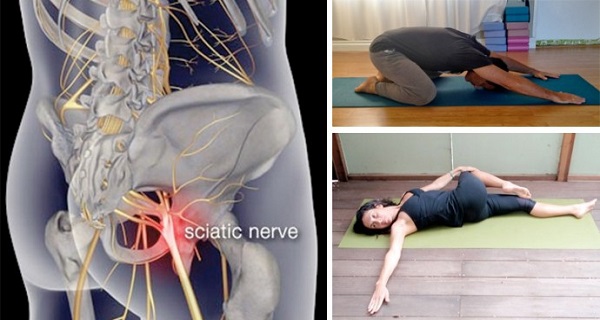Sciatica describes the symptoms of leg pain, sometimes tingling, numbness or weakness that originate in the lower back and travel through the buttock and down the large sciatic nerve in the back of the leg.
Although not a medical diagnosis, it is a symptom of an underlying medical condition, such as a lumbar herniated disc, degenerative disc disease, or spinal stenosis.
On the average, you have 40% probability of suffering some sciatica pain during your life.
Symptoms of Sciatica Nerve Pain
Sciatica is often characterized by one or a combination of the following symptoms:
- Constant pain in only one side of the buttock or leg (rarely it occurs in both legs)
- Pain that is worse when sitting
- Leg pain that is often described as burning, tingling or searing (vs. a dull ache)
- Weakness, numbness or difficulty moving the leg or foot
- A sharp pain that may make it difficult to stand up or to walk
Causes of Sciatica Pain
Sciatica pain generally occurs when the large sciatic nerve is irritated or compressed in the lumbar spine. Herniation in your lumbar spine, the part of your spine bending inward, near you lower-middle back, is a frequent cause of sciatica pain. However, the major culprit that accounts for approximately 70% sciatica cases is piriformis. The piriformis muscle is a small muscle located deep in the buttock region, which spasms and causes buttock pain. The piriformis muscle can also irritate the nearby sciatic nerve thus producing pain, numbness and tingling along the back of the leg and into the foot.
Reducing sciatica pain
You can address your sciatica nerve pain, especially when it results from piriformis, with a few yoga back stretches, which are quite beneficial for exercising your lower back thus reducing or inhibiting sciatica pain.
The Standing Back Twist
The standing back twist is a great exercise for those who aren’t flexible enough to start with some of the more difficult poses. Placing your foot up on a chair and putting your opposite hand on your raised knee (left hand to right knee or right hand to left knee), place your other hand on your hip. Then, turn your upper body to the side of your raised knee to a point where you feel comfortable without moving your hips. Hold this position for 30 seconds then repeat with your other foot.
The Knee Raise
Lie on your back. Draw one knee to your chest keeping the other leg straight. Keeping your shoulders on the floor, pull your knee down with your hands.
THE TWO KNEE TWIST
Lying on your back, open your arms in the form of a capital “T”. Keep your shoulders on the floor and turn your knees out to one side. Stay in this position for a minute then switch sides.
THE SINGLE KNEE TWIST
Lying on your back, bend one knee to a 90° angle. Keep the other leg straight. Place your opposite hand on that knee, while leaving the other arm extended on the floor. Turn to face the arm still on the floor. Keep your shoulders on the floor.
THE TWISTED LUNGE
Although this exercise is more demanding, it’s actually quite beneficial because it really opens your hips. Step one leg forward, knee-bent. Stretch your other leg behind you. It’s important to keep your feet a leg’s length apart. Turn your back placing your opposite elbow on the outside of your bent knee. Bring your palms together and hold this position for 30 seconds.
THE SEATED TWIST
Sit down, your legs straight in front of you. Bending one leg at the knee put it on the outside of your other knee. You can either keep the other leg straight or curl it up, depending on what’s more comfortable for you. Place your opposite elbow on the outside of your bent knee keeping the other hand flat on the floor behind you. Keep your legs pointing forward while facing behind you.
THE CAT POSE
Not only efficient, this exercise is also quite easy. Standing on your hands and knees, bend your back down while lifting your head and chest. You should pull your shoulders backwards at the same time. Hold like this for 10 seconds breathing deeply. Get to a flat back again. Then raising your back, bring your chin and chest together. Hold for ten seconds before you relax. You should do this for 1-2 min.
CHILD’S POSE
This is possibly the least strenuous exercise recommended here. Get down on your hands and knees, your bottom on your heels. Stretch your hands on the floor in front of you. You can hold like this for as long as you like but be cautious not to fall asleep as your legs will suffer.








